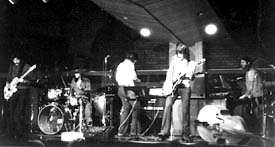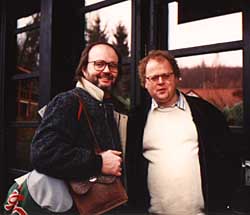Progressive Rock
 Circles within circles; mysteries in the music.
Circles within circles; mysteries in the music.
It was the late 1960’s, long before the phrase “prog rock” was coined. I began a quest to find a new musical voice. At the heart was a desire to combine classical music with rock music, electronic music and theater, to explore new ways to share ideas and images. In part, my journey was launched by my musician’s disdain for “commercial” pop music. More importantly, my natural inclination to search outside traditional music genres fueled my explorations into unusual chord progressions, distinctive rhythms and unexpected melodies. I felt certain that there were new depths to be found in modern music, new mysteries to be discovered.
My search led me to study at University of Wisconsin – Milwaukee. Concurrent with my composition studies at the university, I led a successful rock band and kept busy playing and recording my music. Almost from the start, critics and audiences were moved by our groups’s evolving musical style, even though they were unable to categorize what that musical style was.
Sometimes it was referred to as psychedelic music (although it wasn’t really psychedelic), sometimes as “classical” rock and occasionally as “progressive” rock. It was only years later that the term “prog rock” came into general use. Virtually all my compositions from these years – 1968 to 1975 – have come to be categorized as prog rock, starting with the album “The Bloomsbury People” and ending with my second symphony, “The Talking Symphony.” Some of this material was released on albums: “Bloomsbury People”, “Virginia Woolf” and “Trinity Seaseizesees. In the mid-70’s my band, Snopek, was considered a prog rock band for the first year of its existence, including the release of the album “Nobody to Dream.”
Like many others before us, we followed the advice of our management and record company and became more “pop.” What followed was greater commercial success, but I no longer experienced the energy and sense of innovation I had received during those earlier days.
 Those things that are most truly important to us never really disappear. Our lives are circumscribed by cycles that always return us to our natural centers. Twenty years after the beginning of my musical odyssey, in 1988, Peter Wustmann from Music Is Intelligence (Germany) contacted me and expressed interest in re-releasing my music from that earlier period. To date, he has released “Nobody to Dream,” “Virginia Woolf” and the complete two CD version of “Trinity Seaseizesees.”
Those things that are most truly important to us never really disappear. Our lives are circumscribed by cycles that always return us to our natural centers. Twenty years after the beginning of my musical odyssey, in 1988, Peter Wustmann from Music Is Intelligence (Germany) contacted me and expressed interest in re-releasing my music from that earlier period. To date, he has released “Nobody to Dream,” “Virginia Woolf” and the complete two CD version of “Trinity Seaseizesees.”
Today, many decades after my beginnings, I take great joy in the resurgence of popularity for “prog rock.” Old loves are deepest loves. My adolescent desire for a music that could synthesize diverse musical traditions into something new has matured into a need to refine, record and perform this complex music for audiences everywhere. As a journeyman musician, I have had to write, play and record in all different styles to make a living. But prog rock, along with classical music, is the music I have always come home to, the music that continues to challenge and inspire me.
Who knows where the next circle will take me?